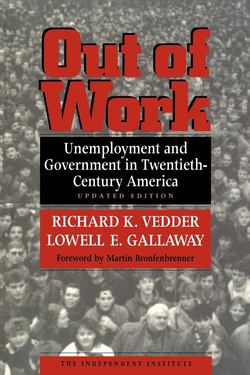Читать книгу Out of Work - Richard K Vedder - Страница 19
NOTES
Оглавление1. The Shorter Oxford English Dictionary (Oxford: Clarendon Press, 1933), 2: 2296, dates the origin of the term “unemployment” to 1888. The term “unemployed” in the modern sense was used as early as 1667. Alfred Marshall uses the term twice on a single page of his Principles of Economics, 8th ed. (London: Macmillan, 1920), p. 710, but nowhere else, although he refers to “inconstancy” of employment in two places.
2. Using the American Economic Association’s Index of Economic Journals (Homewood, Ill: Richard D. Irwin, 1961), we counted unemployment-related articles within the classifications 2.310, Income and Employment Theory—General; 2.311, Underemployment, Full Employment; and 19.202, Employment, Unemployment (counting, among the geographically oriented items, only those for the United States). For the 1890s, there were two articles on statistics of unemployment. In the 1930s, there were sixty articles listed in these classifications, plus numerous other articles in related classifications.
3. See A.C. Pigou, Industrial Fluctuations (London: Macmillan, 1927), p. 185, or his Theory of Unemployment (London: Macmillan, 1933), Part V.
4. For a table on urbanization by decade, see Richard K. Vedder, The American Economy in Historical Perspective (Belmont, Calif.: Wadsworth, 1976), p. 125.
5. See U.S. Department of Commerce, Bureau of the Census, Historical Statistics of the United States, Colonial Times to 1970 (Washington, D.C.: Government Printing Office, 1975), p. 135, or Stanley Lebergott, Manpower in Economic Growth: The American Record Since 1800 (New York: McGraw-Hill, 1964).
6. See Christina Romer, “Spurious Volatility in Historical Unemployment Data,” Journal of Political Economy 94 (1986): 1–37. See also related papers, “Is the Stabilization of the Postwar Economy a Figment of the Data?” American Economic Review 76 (1986), 314–34, and “New Estimates of Prewar Gross National Product and Unemployment,” Journal of Economic History, 46 (1986), 341–52. Romer’s estimates suggest that the standard deviation on the unemployment rate was 1.23 from 1900 to 1929, compared with 2.29 using the official BLS data. For the 1950–79 period, the official estimates yield a standard deviation of 1.37, compared with over 2.00 using the Romer numbers. Romer’s work has been criticized. See, for example, David R. Weir, “The Reliability of Historical Macroeconomic Data for Comparing Cyclical Stability,” Journal of Economic History 46 (1986): 353–65.
7. An important step in filling this void has been provided by John J. Wallis in his “Employment in the Great Depression: New Data and Hypotheses,” Explorations in Economic History 26 (1989): 45–72. Wallis reports employment (not unemployment) changes by state for the critical Depression decade.
8. See the U.S. Department of Commerce and Labor, Bureau of the Census, Special Reports: Occupations at the Twelfth Census (Washington, D.C.: Government Printing Office, 1904), p. ccxxxiv.
9. Ibid.
10. First, we calculated the average duration of unemployment during the previous year for the two racial groups, performing a linear interpolation within the three categories of duration reported in the census. We then calculated the number of unemployed per worker-year of unemployment by dividing the number 12 (representing months) by the estimated mean unemployment duration. Next we divided the reported number of unemployed by the estimated number of unemployed per worker-year. For the entire population, the resulting unemployment rate of 5.68 percent is between the 6.5 percent rate reported by Lebergott for 1899 and the 5.0 percent rate for 1900—some of the unemployment measured in the census occurred in 1899, some in 1900. See Historical Statistics of the United States, p. 135.
11. For example, looking at males with less than an eighth-grade education, both whites and blacks had 84 percent of the work-age population employed in 1940. By 1985, the proportion for blacks had fallen dramatically, to 53 percent, while the decline for whites, to 76 percent, was much less substantial. See Gerald D. Jaynes, “The Labor Market Status of Black Americans: 1939–1985,” Journal of Economic Perspectives 4 (1990): 16.
